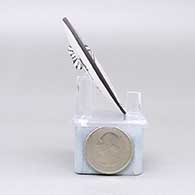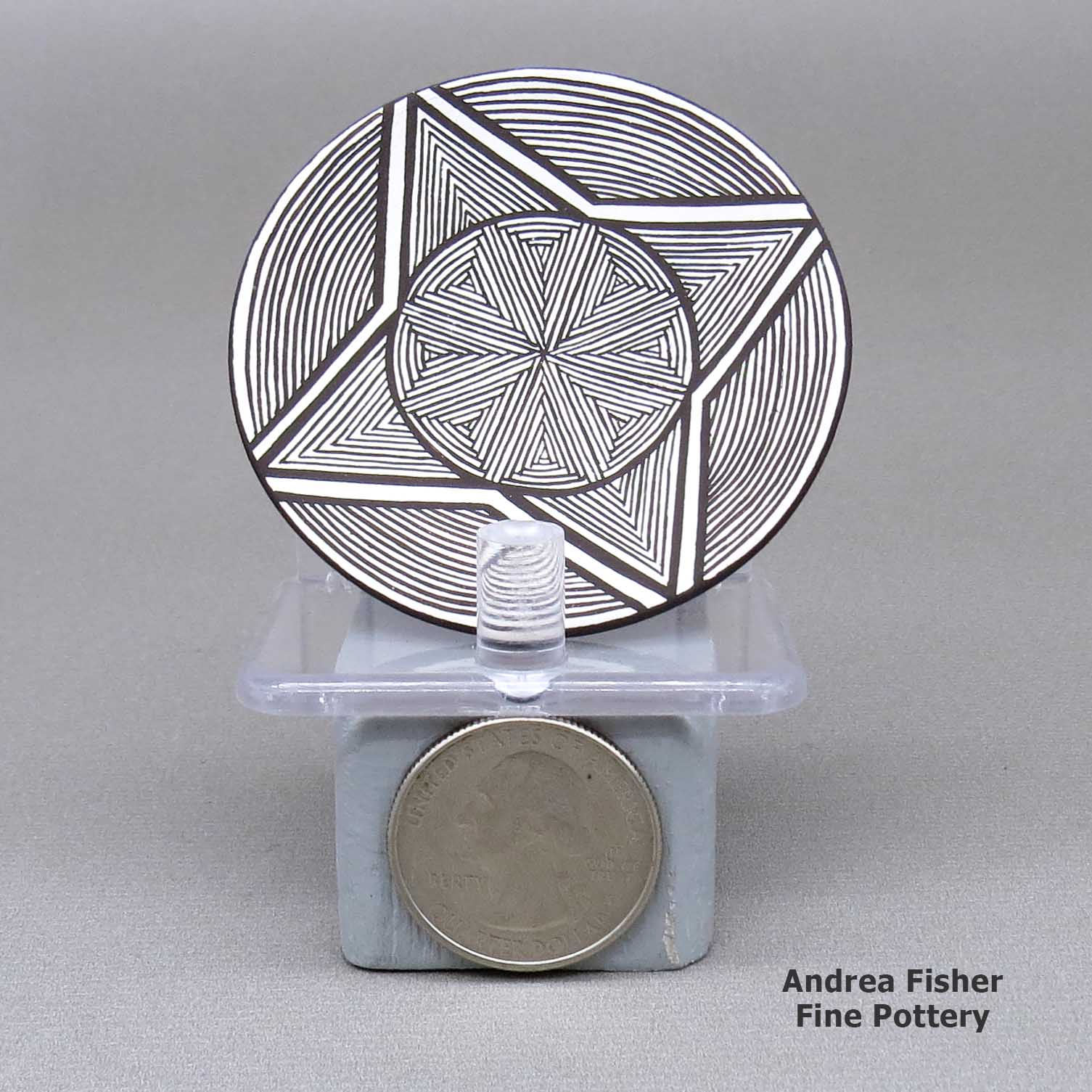
Acoma
$ SOLD
zzac3m150m4
Miniature black-on-white plate with a painted fine line and geometric design on top and an applique and painted butterfly design on bottom
2.25 in L by 2.25 in W by 0.5 in H
Condition: Excellent
Signature: Alisha Sanchez Acoma NM, with roadrunner hallmark
Date Created: 2023
Tell me more! Buy this piece!
(505) 986-1234 - www.andreafisherpottery.com - All Rights Reserved
Alisha Sanchez
Acoma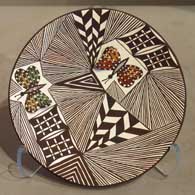
Born in 1980, Alisha Sanchez is the daughter-in-law of Carolyn Concho and learned much of her pottery skills from Carolyn. Carolyn has to be a good teacher and Alisha a good student. She's already earning some prestigious awards in the early years of her career.
Some of the Awards Alisha has Earned
- 2017 Santa Fe Indian Market - First Place, Painted polychrome pottery in the style of Zuni, Acoma, Laguna, any form
- 2017 Santa Fe Indian Market - Second Place, Miniatures, traditional pots
- 2019 Santa Fe Indian Market - Honorable Mention, Painted pottery, any form
Acoma Pueblo
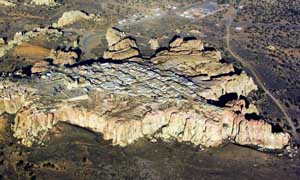
Sky City
According to Acoma oral history, the sacred twins led their ancestors to "Ako," a magical mesa composed mostly of white rock, and instructed those ancestors to make that mesa their home. Acoma Pueblo is called "Sky City" because of its position atop the mesa. Acoma is located about 60 miles west of Albuquerque.
Acoma, Old Oraibi (at Hopi) and Taos all lay claim to being the oldest continuously inhabited community in the U.S. Those competing claims are hard to settle as each village can point to archaeological remnants close by to substantiate each village's claim. While the people of Acoma have an oral tradition that says they've been living in the same area for more than 2,000 years, archaeologists feel more that the present pueblo was established near the end of the major migrations of the 1300s. The location is essentially on the boundary between the Mimbres-Mogollon and Ancestral Puebloan cultures. Each of those cultures has had an impact on the styles and designs of Acoma pottery, especially since modern potters have been getting the inspiration for many of their designs from ancient pot shards they have found while walking on pueblo lands.
Francisco Vasquez de Coronado ascended the cliff to visit Acoma in 1540. He afterward wrote that he "repented having gone up to the place." But the Spanish came back later and kept coming back. In 1598 relations between the Spanish and the Acomas took a really bad turn with the arrival of Don Juan de Oñaté and the soldiers, settlers and Franciscan monks that accompanied him. After ascending to the mesa top, Oñaté decided to force the Acomas to swear loyalty to the King of Spain and to the Pope. When the Acomas realized what the Spanish meant by that, a group of Acoma warriors attacked a group of Spanish soldiers and killed 11 of them, including one of Oñaté's nephews. Don Juan de Oñaté retaliated by attacking the pueblo, burning most of it and killing more than 600 people. Another 500 people were imprisoned by the Spanish, males between the ages of 12 and 25 were sold into slavery and 24 men over the age of 25 had their right foot amputated. Many of the women over the age of 12 were also forced into slavery and were eventually parceled out among Catholic convents in Mexico City. Two Hopi men were also captured at Acoma and, after having one hand cut off, they were released and sent home to spread the word about Spain's resolve to subjugate the inhabitants of Nuevo Mexico.
When word of the massacre and the punishments meted out got back to King Philip in Spain, he banished Don Juan de Oñaté from Nuevo Mexico. Some Acomas had escaped that fateful Spanish attack and returned to the mesa top in 1599 to begin rebuilding. In 1620 a Royal Decree was issued which established civil offices in each pueblo and Acoma had its first governor appointed. By 1680, the situation between the pueblos and the Spanish had deteriorated again to the point where the Acomas were extremely willing participants in the 1680 Pueblo Revolt.
After the successful Pueblo Revolt the Spanish retreated back to Mexico. Refugees from other pueblos began to arrive at Acoma, fearing an eventual Spanish return and reprisals. That strained the resources of Acoma until the Spanish actually did return. The residents of the pueblo had to make a hard decision. Many of the refugees chose to try a peaceful solution: they quickly relocated to the ancient Laguna area and made peace with the Spanish as soon as they appeared in the region.
Over the next 200 years, Acoma suffered from breakouts of smallpox and other European diseases to which they had no immunity. At first they sided with the Spanish against nomadic raiders from the Ute, Apache and Comanche tribes. Then New Mexico changed hands, the railroads arrived and Acoma became dependent on goods brought in from the outside world.
For many years the villagers had been content on the mesa top. Now most live in villages on the valley floor where water, electricity and other necessities are easily available. While a few families still make their permanent home on the mesa top, the old pueblo is used almost exclusively for ceremonies and celebrations these days.
It's the dense, slate-like clay, that allows Acoma pottery to be thin, lightweight and durable. After they form a pot, they paint it with a white slip. Once dry, black and red design motifs are added using mineral and plant derived paints. Fine lines, geometrics, parrots and old Mimbres designs are common motifs. The traditional paintbrush is chewed from the yucca leaf. Historically, Acoma was known for large, thin-walled "ollas," jars used for storing food and water. With the arrival of the railroad and tourists in the 1880s, Acoma potters adapted the size, shapes and styles of their pots in order to appeal to the new buyers.
Acoma potters felt it was an inappropriate display of ego to sign a pot up into the mid-1960s. Then Lucy Lewis, Jessie Garcia and Marie Z. Chino started signing their pots. The 1960s is also a time when the primary Acoma white clay vein passed through a layer of widely distributed impurities, impurities that passed through the clay filtering process and showed up only during and after the firing. The problem was so bad it affected virtually every Acoma potter and every pot they made. Thankfully, by the late 1960s they had dug through that layer of clay and into a deeper layer that didn't have the problem.


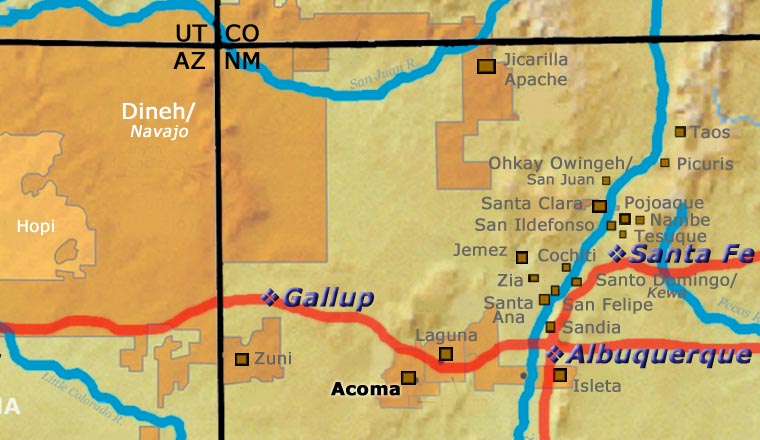
Acoma Pueblo at Wikipedia
Pueblo of Acoma official website
Pueblos of the Rio Grande, Daniel Gibson, ISBN-13:978-1-887896-26-9, Rio Nuevo Publishers, 2001
Upper photo courtesy of Marshall Henrie, Creative Commons Attribution-Share Alike 3.0 Unported License
Miniatures
Most people think that miniature pottery is something new in the world of Native American pottery. In reality, archaeologists have found miniature pottery in the remains of ancient ruins in Chaco Canyon, Mesa Verde, across eastern Arizona, southern New Mexico and south to the Paquimé and Casas Grandes region in northern Mexico. Archaeologists working in the eastern US have found miniature pottery spread across Early Woodland Culture sites, too, dated up to 1700 years ago.
We have no idea as to why the ancients created miniature pottery but there's lots of speculation. Perhaps it was made as toys for children. Perhaps it was made by children learning to make pottery, and as their expertise grew, the size of their pieces grew, too. Perhaps it was made and placed in a firing pit as a good luck charm, hoping that other pots being fired in the pit would survive the firing process and not crack or break. Perhaps it was made for some ceremonial purpose we have no possibility of knowing. We do know that in North America, almost every pottery-making group of ancients made miniature pottery. They decorated it, too, just like the full size pottery the women of the time were making.
As the rebirth of traditionally made Native American pottery has unfolded over the last century, research into the ancient forms, styles and designs has also brought the miniature back into focus. There are more than a few potters these days making tiny gems again, similar to and, at the same time, more refined than the products of the potters of prehistory. And while some are still being made by children learning as they grow up, many more are being made by established adult potters. Some have made their entire careers around the making of miniatures while others sometimes make a few miniatures to complement the full range of forms and styles of full size pieces they make.
Delores Sanchez Family Tree
Disclaimer: This "family tree" is a best effort on our part to determine who the potters are in this family and arrange them in a generational order. The general information available is questionable so we have tried to show each of these diagrams to living members of each family to get their input and approval, too. This diagram is subject to change should we get better info.
- Delores Sandoval Sanchez (ca. 1888-1991) & Toribio Sanchez
- Marie S. Juanico (1937-)
- Delores Aragon (Juanico) (1969-)
- Katherine Lewis (1932-)
- Bernard Lewis (1957-) & Sharon Lewis (1959-)
- Eric Lewis (1978-)
- Carolyn Concho (1961-)
- Alisha Sanchez & George Concho, Jr.
- Shaylene Chino
- Alisha Sanchez & George Concho, Jr.
- Diane Lewis (1959-)
- Judy Lewis (1966-)
- Rebecca Lucario(1951-)
- Amanda Lucario (1984-)
- Daniel Lucario (1969-)
- Marilyn Ray (1954-)
- Edward Lewis Jr. & Eva Concho
- Edward Lewis III
- Bernard Lewis (1957-) & Sharon Lewis (1959-)
- Ethel Shields (1926-) & Don Shields
- Charmae Shields Natseway (1958-) & Thomas Natseway (1953-)(Laguna)
- Chris Shields & Michelle Shields (1972-)
- Curtis Shields
- Isaac Shields
- Natasha Shields
- Jack Shields (c.1961-)
- Judy Shields (daughter-in-law)
- Verda Mae Shields (daughter-in-law)
Some of the above info is drawn from Southern Pueblo Pottery, 2000 Artist Biographies, by Gregory Schaaf, © 2002, Center for Indigenous Arts & Studies
Other info is derived from personal contacts with family members and through interminable searches of the Internet and cross-examination of the data found.
Copyright © 1998-2024 by


